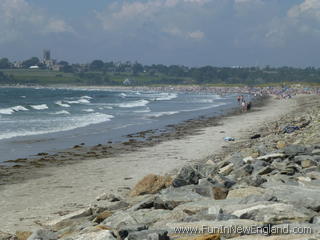 Fun
In
New
England
- Rhode Island
Fun
In
New
England
- Rhode Island
 Fun
In
New
England
- Rhode Island
Fun
In
New
England
- Rhode Island
Search for Places or Activities in RINote: Since the pandemic many businesses have closed and information here may not be up-to-date. Check their website or call before going.List best and most popular Beaches in Rhode Island Browse all Beaches in Rhode Island (by region) Rhode Island Beaches InformationInformation about RI State Beaches parking rates and passes can be found here. This includes Charlestown Breachway, East Beach in Charlestown; East Matunuck in South Kingstown; Misquamicut in Westerly; Roger Wheeler, Scarborough North and South, and Salty Brine in Narragansett.Weather and Tides For weather forecasts check the National Weather Service or The Weather Channel. For tide predictions go to NOAA Tide Predictions or CyberAngler Dangerous Currents Whenever at a beach for swimming be especially aware of rip currents (sometimes incorrectly called rip tides or undertoe). These are powerful water currents that can pull even an experienced swimmer out to sea and possibly cause drowning. It is estimated that there are over 100 fatalities each year due to rip currents. The National Weather Service has excellent information about rip currents here. Rip currents can occur at any beach, but are more prevalent at beaches facing the open waters of the Atlantic Ocean. Another danger to beware of is rip tides or tidal jets. These are caused by the inrush or outflow of water through the inlets and the mouths of estuaries, bays and harbors during changing tides. Finally, people, especially children, wading into the wave break zone should be careful of run-up, breaking, and backwash which can knock people down and pull them under the water. The United States Lifesaving Association has more information regarding dangerous currents. Beach Hazards Insects and sea creatures can be a hazard to humans. Many beaches have biting insects including horseflies, deerflies, greenflies, mosquitos, bees and hornets (especially yellow jackets), sand fleas, deer ticks, and gnats. These insects become especially bothersome at night, early morning, evening, and on overcast days. The greenflies on parts of Cape Cod are vicious. Always bring insect repellant to the beach. A common danger is jellyfish. Many people are stung each year by jellyfish. In 2006 there were even many sightings of Portugese-Man-Of-War on Rhode Island and Massachusetts beaches. These dangerous jellyfish normally reside in warmer southern waters. There stinging tentacles can extend many feet under the water. Underwater hazards can include rocks, broken shells, broken glass, crabs, sea anemones, and sea urchins. Shark attacks have become more prevalent in recent years. Sharks sometimes mistake swimmers for food when the water is murky or churned up or there are seals in the area. The water itself may become polluted or toxic due to sewage runoff, man-made waste/dumping, and naturally ocurring phenomena such as algae bloom or red tide. These problems close several beaches each year because they can cause skin rashes, infections, and sickness (if the water is swallowed). Finally, everyone must remember to bring sunblock. Sunburns are the most common hazard of the beach. Skin cancer is a rising epidemic in the USA. People who fall asleep in the sun or overexert themselves can also get sun poisoning or sunstroke. |
 Second Beach, Middletown |